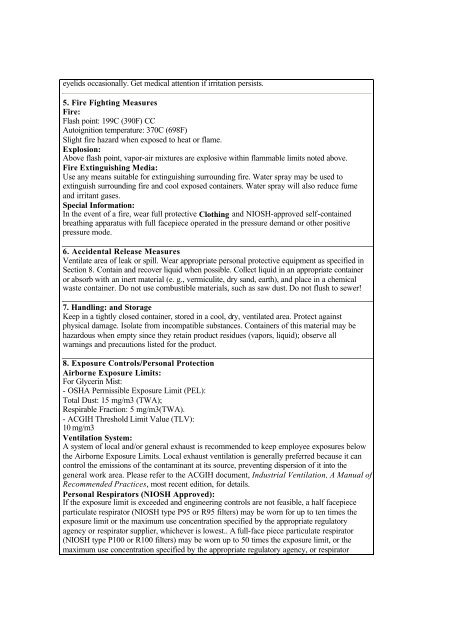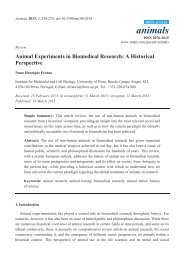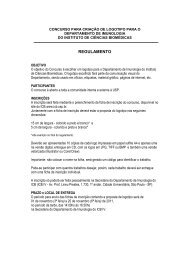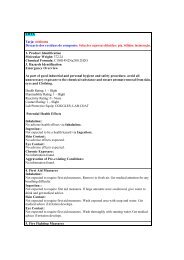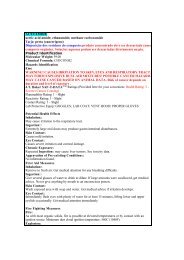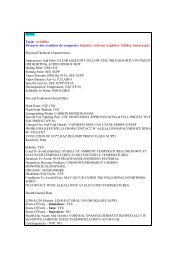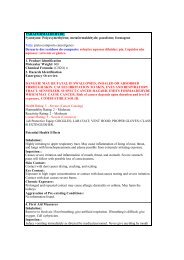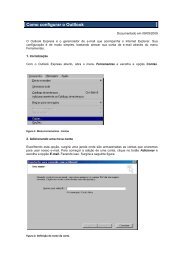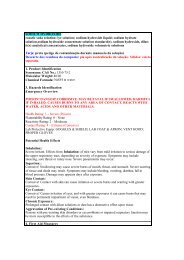GLYCEROL Synonyms: 1,2,3-propanetriol; glycerin; glycol ... - USP
GLYCEROL Synonyms: 1,2,3-propanetriol; glycerin; glycol ... - USP
GLYCEROL Synonyms: 1,2,3-propanetriol; glycerin; glycol ... - USP
Create successful ePaper yourself
Turn your PDF publications into a flip-book with our unique Google optimized e-Paper software.
eyelids occasionally. Get medical attention if irritation persists.<br />
5. Fire Fighting Measures<br />
Fire:<br />
Flash point: 199C (390F) CC<br />
Autoignition temperature: 370C (698F)<br />
Slight fire hazard when exposed to heat or flame.<br />
Explosion:<br />
Above flash point, vapor-air mixtures are explosive within flammable limits noted above.<br />
Fire Extinguishing Media:<br />
Use any means suitable for extinguishing surrounding fire. Water spray may be used to<br />
extinguish surrounding fire and cool exposed containers. Water spray will also reduce fume<br />
and irritant gases.<br />
Special Information:<br />
In the event of a fire, wear full protective Clothing and NIOSH-approved self-contained<br />
breathing apparatus with full facepiece operated in the pressure demand or other positive<br />
pressure mode.<br />
6. Accidental Release Measures<br />
Ventilate area of leak or spill. Wear appropriate personal protective equipment as specified in<br />
Section 8. Contain and recover liquid when possible. Collect liquid in an appropriate container<br />
or absorb with an inert material (e. g., vermiculite, dry sand, earth), and place in a chemical<br />
waste container. Do not use combustible materials, such as saw dust. Do not flush to sewer!<br />
7. Handling: and Storage<br />
Keep in a tightly closed container, stored in a cool, dry, ventilated area. Protect against<br />
physical damage. Isolate from incompatible substances. Containers of this material may be<br />
hazardous when empty since they retain product residues (vapors, liquid); observe all<br />
warnings and precautions listed for the product.<br />
8. Exposure Controls/Personal Protection<br />
Airborne Exposure Limits:<br />
For Glycerin Mist:<br />
- OSHA Permissible Exposure Limit (PEL):<br />
Total Dust: 15 mg/m3 (TWA);<br />
Respirable Fraction: 5 mg/m3(TWA).<br />
- ACGIH Threshold Limit Value (TLV):<br />
10 mg/m3<br />
Ventilation System:<br />
A system of local and/or general exhaust is recommended to keep employee exposures below<br />
the Airborne Exposure Limits. Local exhaust ventilation is generally preferred because it can<br />
control the emissions of the contaminant at its source, preventing dispersion of it into the<br />
general work area. Please refer to the ACGIH document, Industrial Ventilation, A Manual of<br />
Recommended Practices, most recent edition, for details.<br />
Personal Respirators (NIOSH Approved):<br />
If the exposure limit is exceeded and engineering controls are not feasible, a half facepiece<br />
particulate respirator (NIOSH type P95 or R95 filters) may be worn for up to ten times the<br />
exposure limit or the maximum use concentration specified by the appropriate regulatory<br />
agency or respirator supplier, whichever is lowest.. A full-face piece particulate respirator<br />
(NIOSH type P100 or R100 filters) may be worn up to 50 times the exposure limit, or the<br />
maximum use concentration specified by the appropriate regulatory agency, or respirator


